There are many traditional holidays specific to the culture and history of Polynesia. However, because Christmas is among the most celebrated holidays on the earth, this holiday is also celebrated by many Polynesian families. As we know, Christmas was introduced by Christian missionaries as they traveled through various Polynesian Islands in the 1700 to 1800.
Polynesian Christmas customs are as varied as American traditions. Gift giving, large family get togethers and even Santa Claus and religious observances are common throughout many communities.
This blog will help you learn more about modern Christmas traditions across the Pacific Islands which are both unique to each family and are practiced by the vast majority.
Hawaiian Christmas Traditions
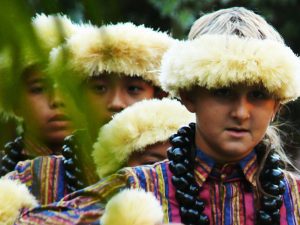
Special hula performances are usually around the Christmas holiday in Hawai’i
Terry Panee, who serves as the Manager in the Center’s Hawaiʻi Village states, “Christmas is not a traditional Hawaiian celebration. It was introduced after the missionaries and Christianity was introduced in Hawaiʻi. It has become a local celebration here in the islands. Celebrating Christmas is part of who we are today. Hawaiʻi is a multicultural society, and so many cultural aspects are added to the celebrations.
Food is always a way we celebrate and is always part of any get together with family and friends. On a Christmas table, we have a wide range of foods, including Hawaiian, Japanese, Chinese, Filipino, Polynesian, and American. We love eating anything good whether you are of that culture or not. As for my family tradition, Hawaiian food usually comes on New Year’s. At Christmas time, we usually eat steaks, lobsters, crab, and shrimp. Serve with all of the other sides, such as noodles, sushi and raw fish.
Decorating with the lights, and going to view other people’s Christmas lights was very typical. I recalled a place called “Christmas Lane” down in Kahaluu that used to get a lot of people driving by throughout the month of December to see the beautiful lights and decorations. On the last week before Christmas, some of the families would have treats and cookies to give out. One house would have a Santa in the driveway for all the kids to wave and take pictures with. There was a competition amongst the residents of that cul-de-sac and so every year was something special. We went there when I was growing up, and later took my children to see and take pictures. Often times we would go multiple times during the Christmas season. Unfortunately, some of the residents have moved and they no longer have the competition, but many still decorate their homes.
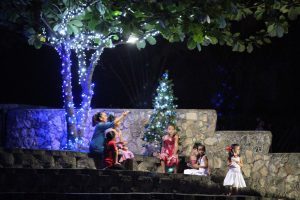
Image courtesy of Polynesian Cultural Center!
And now there’s a lot more of this going on in different areas, though, everybody is looking forward to going wherever they have Christmas displays. There is a Christmas trolley where you ride through Honolulu and see all the lights, listen to the music, and end up in Honolulu Hale (Honolulu City Hall), which is decorated for the Christmas season.
It is a family holiday. It’s always about visiting family and friends. Christmas celebrations can be loud, depending on the family. However, some families are not as audible as others. We usually gather together for a meal. Often times you’ll go to eat at multiple places, such as your in-laws’ or siblings’. You’re eating all day long! Some may split it and say Christmas Eve will be here and Christmas Day will be there.”
Reflecting on his years as a student at Brigham Young University-Hawaiʻi, Terry added, “I always took home a bunch of friends who were not from Hawaiʻi or were not going home to the outer islands. They would come over, spend a day or two, or three, depending when Christmas is over. Our place was filled with friends, distant relatives, and everybody, all celebrating together, because it’s family time. They can celebrate, with us, even if they are not home with their families. They are part of our family. We are always including everybody else. Everyone needs a place to stay for Christmas.
Terry further shares that “in Hawaiian, we have a term called ‘hanai’. Some people think hanai means to adopt; a hanai child, hanai brother, or sister. It’s not adopted in a legal sense, but hanai in Hawaiian means ‘to feed’. When you decide to hanai somebody, you take responsibility for their total well-being. Not only through food but also by ensuring they’re taken care of, including shelter if they need a place to stay.”
Aotearoa Christmas Traditions
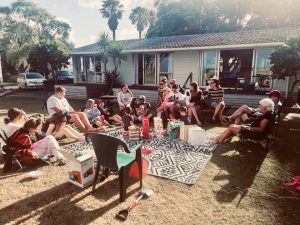
Māori family enjoys an outdoor picnic and a Christmas exchange. Photo courtesy of Gloria Miller.
Kim Makekau, manager of the Aotearoa Village, explains that unity, love, and family are the three primary aspects of Christmas in New Zealand.
He further adds, “New Zealand Christmases are similar in their practices to any other Christian nation. New Zealand Christmas is in the summer. During summer, families go on vacation. Either they gather at the beach or they will go the marae to see their other families. They celebrate with gift-giving, a Christmas tree, and songs. Again, not everybody follows these customs, but the vast majority do.
Christmas in New Zealand is hot, instead of cold. Contrary, the concept of Santa Claus, the snow with the reindeer, and all that, don’t connect. However, the stories are known because that was taught by the Westerners when they settled in.
Christmas Eve could be celebrated with feasting and eating. It could also be celebrated with gift-giving and the opening of gifts. Some people open their presents the night before, and some open them on Christmas morning. Usually, the focus is on the kids. If you have Christmas on the marae, it’s generally a family reunion, a big event, and people can just be together.”
Fijian Christmas Traditions

Some Fijian families take to the beach on Christmas.
Saimoni Naivalu, Fiji Village Cultural Ambassador, shares that Christmas themes for the islands of Fiji are getting together, visiting family and lots of eating.
“It’s about family. As many Fijians live and work in the city, everyone will return to their own islands to celebrate Christmas with their families. During the Christmas holiday, we also visit relatives we haven’t seen for a while.
Fiji is a very Christian country. On Christmas Eve and morning, the people in the village gather for prayers expressing their gratitude and remembering the birth of Christ. Often, they do a reenactment of Jesus’s birth.
Fijians love wearing new attire during Christmas, which symbolizes a celebration of new beginnings. Often, families wear their unique matching attires.
Lovo (a Fijian earth oven) is the main form of meal preparation to feed everyone in the family. The staples prepared into the lovo, including taro, fish and pork. Kava, a root drink, is also served.”
Samoan Christmas Traditions
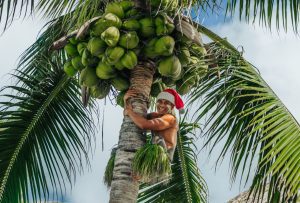
Image of Creasepaul, Senior Cultural Ambassador at the Polynesian Cultural Center
In Samoa, Christmas is the time to reconnect with families, express gratitude, share delicious meals, and spend time with loved ones.
Creasepaul Tofa, our Samoa Village Senior Cultural Ambassador, shares that a father gives presents to his kids on Christmas day. “The gifts have to be practical. For instance, the son might be given a chainsaw or machete to work the land, and the daughter might be given money to spend on valuable things.
On Christmas Eve, the people in the village gather at the chapel for prayer. After the prayer, families return to their homes to enjoy tea time. In my family, we have koko samoa, bread (falaoa), and biscuits (masi) with plenty of butter prepared for the ‘Christmas Eve Tea’.
Food is crucial in our culture. Umu, a traditional Samoan ground oven, is the primary cooking (method) on Christmas Day to feed everyone in the family. You’ll always find the staples in the umu, including taro, breadfruit, banana, luau, pig and fish, served with other delicious local Samoan food.
After a big family lunch (to’ana’i) on Christmas Day, then it’s time for fun and games (traditional games which may include Samoan kirikiti (cricket), lape, and modern games include rugby and volleyball.”
Tahitian Christmas Traditions
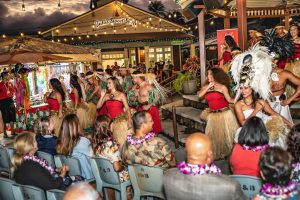
A special Tahitian inspired performance during our annual Christmas at the Hukilau Marketplace event
Christmas is a quiet family celebration on the Tahiti islands. There are no parties and dancing, only talking and eating. On Christmas Eve, families gather and pray at their homes.
Heitiare Panee, Tahiti Village Manager, remembers celebrating Christmas like this in her family. “A tradition that my family often does on Christmas is filling your shoes with goodies. It’s a French influence tradition. Growing up, my siblings and I looked forward to this tradition on Christmas morning.
Once we woke up in the morning, we raced to fill our shoes with goodies and set them next to the Christmas tree. The amusing element is that the bigger your shoes, the more goodies you’ll get. “
During Christmas, families assemble and enjoy the finest meals available. The food available includes a blend of Tahitian and French cuisines. In Tahiti, they serve smoked turkey for Christmas dinner opposite to the American Thanksgiving. Foie gras and oysters are staples on the Christmas table. This is the only day you’ll eat heaps of them.
Tongan Christmas Traditions

Tongan families wrap their Christmas season around family.photo courtesy of the Walter and Telesia Tonga family.
Vahamamao Lauhingoa, who volunteered with her late husband, Apolosi, for 15 months as Cultural Advisors in the Tonga Village, shared two of her favorite traditions.
“Tongans have a deep connection to family hierarchy. The oldest sister is expected to be the leader of their extended family. They carry both the responsibility for tending to the needs of their family and are expected to be highly respected for their position. Family members will visit the sister on Christmas Eve to bestow gifts and to thank the sister for her service to the family.
Tongans are noted for their harmonious singing and musical presentations. Many communities have organized bands. On Christmas Eve, local choirs and musicians will wander through the village sharing familiar hymns and Christmas songs.”
Conclusion
As you can see, Christmas in Polynesia is strongly based on the typical celebration of birth, renewal, family and food. However you chose to celebrate this joyous season, we wish you many fond memories and a blessed New Year to come.
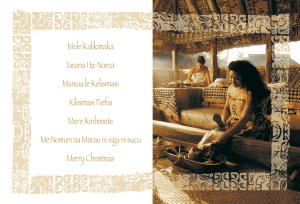
Whether we say “Merry Christmas” in Hawaiian, Tahitian, Samoan, Tongan, Maori, or Fijian, it still means best wishes to you and your family this holiday season.
Bio of Quinney Suaava, Blogger at the Polynesian Cultural Center
 My family, culture, talent, and knowledge are the things I treasure the most. And the things I love to do are spending time with the people I love, traveling to different places, cooking Samoan food, singing and playing the ukulele, learning new things about life, and the list goes on! All of these contribute to my passion, experience and love for writing.
My family, culture, talent, and knowledge are the things I treasure the most. And the things I love to do are spending time with the people I love, traveling to different places, cooking Samoan food, singing and playing the ukulele, learning new things about life, and the list goes on! All of these contribute to my passion, experience and love for writing.


Recent Comments